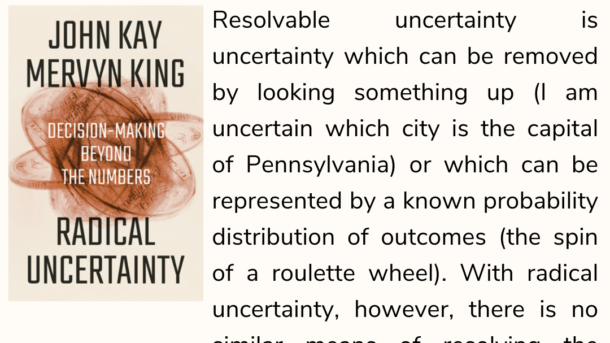The crisis of 2007–08 represented – obviously – a failure of economic analysis and economic policy. But while recognising the seriousness and cost of the financial crisis, economists have generally been reluctant to accept that their intellectual framework is in need of revision. Economists (used to) distinguish risk, by which they meant unknowns which could be described with probabilities, from uncertainty, which could not. They had already adopted mathematical techniques which gave the term ‘risk’ a different meaning from that of everyday usage. In this book we will describe the considerable confusion and economic damage which has arisen as a result of the failure to recognise that the terms ‘risk’, ‘uncertainty’ and ‘rationality’ have acquired technical meanings in economics which do not correspond to the everyday use of these words. And over the last century economists have attempted to elide that historic distinction between risk and uncertainty, and to apply probabilities to every instance of our imperfect knowledge of the future. The difference between risk and uncertainty was the subject of lively debate in the inter-war period. Two great economists – Frank Knight in Chicago and John Maynard Keynes in Cambridge, England – argued forcefully for the continued importance of the distinction. Knight observed that ‘a measurable uncertainty, or “risk” proper, as we shall use the term, is so far different from an unmeasurable one that it is not in effect an uncertainty at all’. Keynes made a similar distinction. In an article summarising his magnum opus, The General Theory of Employment, Interest and Money , he wrote: By ‘uncertain’ knowledge, let me explain, I do not mean merely to distinguish what is known for certain from what is only probable. The game of roulette is not subject, in this sense, to uncertainty; nor is the prospect of a Victory bond being drawn. Or, again, the expectation of life is only slightly uncertain. Even the weather is only moderately uncertain. The sense in which I am using the term is that in which the prospect of a European war is uncertain, or the price of copper and the rate of interest twenty years hence, or the obsolescence of a new invention, or the position of private wealth-owners in the social system in 1970. About these matters there is no scientific basis on which to form any calculable probability whatever. We simply do not know. The title of this book, and its central concept, is radical uncertainty . Uncertainty is the result of our incomplete knowledge of the world, or about the connection between our present actions and their future outcomes. Depending on the nature of the uncertainty, such incomplete knowledge may be distressing or pleasurable. I am fearful of the sentence the judge will impose, but look forward to new experiences on my forthcoming holiday. We might sometimes wish we had perfect foresight, so that nothing the future might hold could surprise us, but a little reflection will tell us that such a world would be a dull place. We have chosen to replace the distinction between risk and uncertainty deployed by Knight and Keynes with a distinction between resolvable and radical uncertainty. Resolvable uncertainty is uncertainty which can be removed by looking something up (I am uncertain which city is the capital of Pennsylvania) or which can be represented by a known probability distribution of outcomes (the spin of a roulette wheel). With radical uncertainty, however, there is no similar means of resolving the uncertainty – we simply do not know. Radical uncertainty has many dimensions: obscurity; ignorance; vagueness; ambiguity; ill-defined problems; and a lack of information that in some cases but not all we might hope to rectify at a future date. These aspects of uncertainty are the stuff of everyday experience.
Wanted to cover more passages of the previous book. After some conversations though, I couldn’t really find any new fresh insights beyond the picture of the framework that I had already posted.
One thing that struck me was that most books, for commercial purposes, try to jam fit complex and intricate narratives into 1 model or framework of thinking. After all, simplicity sells. Think of books like grit, vulnerability, good to great. Books with a simple common narrative that works onto a Ted Talk. The success of an idea usually doesn’t lie in how accurate it is, but how easy it sticks. So as we move to cover new books, do always consider the above and never let 1 single narrative dictate your thoughts. After all, multi-model thinking usually leads to much more accurate judgements and predictions.
Moving on, this book is about Radical Uncertainty, where historical data offers zero guidance in helping one predict future outcomes. One example in the book was about Obama’s decision to send in the Navy Seals to capture Osama Bin Laden. He had no historical data to refer to, estimated probabilities from his analysts and ultimately had to make a judgement call. This book is about learning how to deal with this.



